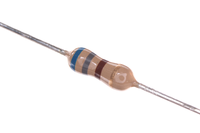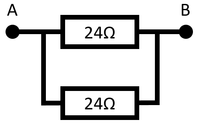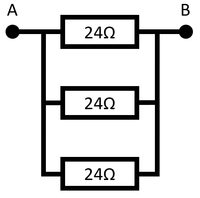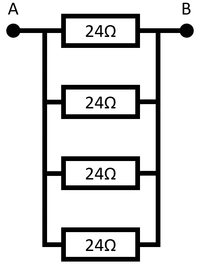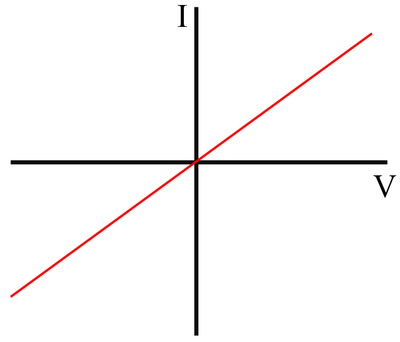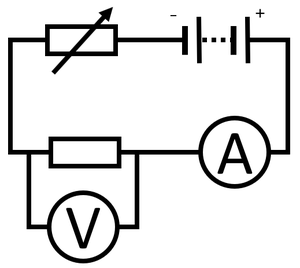Difference between revisions of "Resistor"
| (One intermediate revision by the same user not shown) | |||
| Line 128: | Line 128: | ||
:[https://www.amazon.co.uk/gp/product/1782946403/ref=as_li_tl?ie=UTF8&camp=1634&creative=6738&creativeASIN=1782946403&linkCode=as2&tag=nrjc-21&linkId=32a0abb60dff015b15b50e9b1d7b4644 ''Resistors; variable resistors, pages 60, 65, GCSE Combined Science Trilogy; Physics, CGP, AQA ''] | :[https://www.amazon.co.uk/gp/product/1782946403/ref=as_li_tl?ie=UTF8&camp=1634&creative=6738&creativeASIN=1782946403&linkCode=as2&tag=nrjc-21&linkId=32a0abb60dff015b15b50e9b1d7b4644 ''Resistors; variable resistors, pages 60, 65, GCSE Combined Science Trilogy; Physics, CGP, AQA ''] | ||
:[https://www.amazon.co.uk/gp/product/1782945970/ref=as_li_tl?ie=UTF8&camp=1634&creative=6738&creativeASIN=1782945970&linkCode=as2&tag=nrjc-21&linkId=a120d24dcc7cc7a58192069a3aafc1d2 ''Resistors; variable resistors, pages 62, 67, GCSE Physics; The Complete 9-1 Course for AQA, CGP, AQA ''] | :[https://www.amazon.co.uk/gp/product/1782945970/ref=as_li_tl?ie=UTF8&camp=1634&creative=6738&creativeASIN=1782945970&linkCode=as2&tag=nrjc-21&linkId=a120d24dcc7cc7a58192069a3aafc1d2 ''Resistors; variable resistors, pages 62, 67, GCSE Physics; The Complete 9-1 Course for AQA, CGP, AQA ''] | ||
| + | |||
| + | ====Edexcel==== | ||
| + | |||
| + | :[https://www.amazon.co.uk/gp/product/1782948163/ref=as_li_tl?ie=UTF8&camp=1634&creative=6738&creativeASIN=1782948163&linkCode=as2&tag=nrjc-21&linkId=0fdbfd5dd397d6e24a9dfb250f08587f ''Resistors (fixed), page 228, GCSE Physics, CGP, Edexcel ''] | ||
| + | :[https://www.amazon.co.uk/gp/product/1292120223/ref=as_li_tl?ie=UTF8&camp=1634&creative=6738&creativeASIN=1292120223&linkCode=as2&tag=nrjc-21&linkId=068ecf40278c32406a7f1c6e66751417 ''Resistors; parallel circuits, page 147, GCSE Physics, Pearson Edexcel ''] | ||
| + | :[https://www.amazon.co.uk/gp/product/1292120223/ref=as_li_tl?ie=UTF8&camp=1634&creative=6738&creativeASIN=1292120223&linkCode=as2&tag=nrjc-21&linkId=068ecf40278c32406a7f1c6e66751417 ''Resistors; series circuits, pages 146-147, GCSE Physics, Pearson Edexcel ''] | ||
| + | |||
| + | ====OCR==== | ||
| + | :[https://www.amazon.co.uk/gp/product/0198359837/ref=as_li_tl?ie=UTF8&camp=1634&creative=6738&creativeASIN=0198359837&linkCode=as2&tag=nrjc-21&linkId=3c4229e8b023b2b60768e7ea2307cc6f ''Resistors, pages 104, 106, 110, 113, Gateway GCSE Physics, Oxford, OCR ''] | ||
| + | :[https://www.amazon.co.uk/gp/product/1782945695/ref=as_li_tl?ie=UTF8&camp=1634&creative=6738&creativeASIN=1782945695&linkCode=as2&tag=nrjc-21&linkId=ceafcc80bcad6b6754ee97a0c7ceea53 ''Resistors, pages 176, 178, 179, Gateway GCSE Combined Science; The Revision Guide, CGP, OCR ''] | ||
| + | :[https://www.amazon.co.uk/gp/product/1782945687/ref=as_li_tl?ie=UTF8&camp=1634&creative=6738&creativeASIN=1782945687&linkCode=as2&tag=nrjc-21&linkId=9a598e52189317a20311d7a632747bc9 ''Resistors, pages 45-47, Gateway GCSE Physics; The Revision Guide, CGP, OCR ''] | ||
Latest revision as of 18:16, 18 December 2019
Contents
Key Stage 3
Meaning
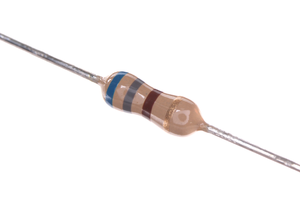
A picture of a resistor.
A resistor is a component in an electrical circuit which makes it difficult to electricity to pass through it.
About Resistors
- A resistor is a component designed to have a particular resistance.
- Resistors are added to circuits to control the current which will pass through for a certain potential difference.
- The greater the resistance of a resistor the smaller the current will be.
- The resistance of a resistor can be found by attaching an ammeter in series with the resistor and a voltmeter in parallel with the resistor.
- All components in a circuit act as resistors, including wires. The longer a wire the more resistance it will have to a current.
| A resistor. | The symbol for a resistor. |
Key Stage 4
Meaning

The symbol for a resistor.
A resistor is a component in an electrical circuit which makes it difficult to electricity to pass through it.
About Resistors
- A resistor is a component designed to have a particular resistance.
- Resistors are added to circuits to control the current which will pass through for a certain potential difference.
- The greater the resistance of a resistor the smaller the current will be.
- The resistance of a resistor can be found by attaching an ammeter in series with the resistor and a voltmeter in parallel with the resistor.
- All components in a circuit act as resistors, including wires. The longer a wire the more resistance it will have to a current.
Resistors in Series
- Adding resistors in series increases the resistance in the circuit.
- The resistance of each resistor can be added together.
| The resistance between points A and B is:
5Ω. | |
| The resistance between points A and B is:
2Ω + 5Ω = 7Ω | |
| The resistance between points A and B is:
2Ω + 5Ω + 9Ω = 16Ω |
Resistors in Parallel
NB: You only need to know what happens with identical resistors in parallel.
- When identical resistors are added in parallel there are more paths for the electricity so the resistance is reduced.
| Two identical resistors in parallel gives twice the number of paths, so has half the resistance.
The resistance between points A and B is 12Ω. |
Three identical resistors in parallel gives three times the number of paths, so has a third of the resistance.
The resistance between points A and B is 8Ω. |
Four identical resistors in parallel gives four times the number of paths, so has a quarter of the resistance.
The resistance between points A and B is 6Ω. |
IV Graph
Description
The IV Graph for a resistor shows that:
- As potential difference increases, increases.
- The relationship between potential difference and current is linear (the gradient is constant).
- The current is directly proportional to potential difference.
Explanation
- Resistors obey Ohm's Law so the "current through a resistor at constant temperature is directly proportional to the potential difference across the resistor."
Obtaining the IV Graph
|
References
AQA
- Resistor, pages 46-7, 52, GCSE Physics; Student Book, Collins, AQA
- Resistor; non-ohmic, page 59, GCSE Physics; Student Book, Collins, AQA
- Resistors in parallel, pages 55, 63, GCSE Physics; Student Book, Collins, AQA
- Resistors in series, pages 54, 57, 63, GCSE Physics; Student Book, Collins, AQA
- Resistors, pages 293, 295-6, GCSE Combined Science Trilogy 1, Hodder, AQA
- Resistors, pages 40-1, GCSE Physics, Hodder, AQA
- Resistors, pages 52-53, 55, 58-59, 61, 70, GCSE Physics; Third Edition, Oxford University Press, AQA
- Resistors, pages 60, 66, 77-79, GCSE Combined Science Trilogy; Physics, CGP, AQA
- Resistors, pages 62, 68, 79-81, GCSE Physics; The Complete 9-1 Course for AQA, CGP, AQA
- Resistors; circuit symbol, page 38, GCSE Physics, Hodder, AQA
- Resistors; I-V characteristics, pages 65, 66, GCSE Combined Science Trilogy; Physics, CGP, AQA
- Resistors; I-V characteristics, pages 67, 68, GCSE Physics; The Complete 9-1 Course for AQA, CGP, AQA
- Resistors; light-dependant resistors (LDRs), pages 60, 80, 81, GCSE Combined Science Trilogy; Physics, CGP, AQA
- Resistors; light-dependant resistors (LDRs), pages 62, 82, 83, GCSE Physics; The Complete 9-1 Course for AQA, CGP, AQA
- Resistors; light-dependent (LDRs), pages 299-300, GCSE Combined Science Trilogy 1, Hodder, AQA
- Resistors; ohmic and non-ohmic, page 298, GCSE Combined Science Trilogy 1, Hodder, AQA
- Resistors; ohmic and non-ohmic, page 43, GCSE Physics, Hodder, AQA
- Resistors; thermistors, pages 298-9, GCSE Combined Science Trilogy 1, Hodder, AQA
- Resistors; thermistors, pages 60, 80, 81, GCSE Combined Science Trilogy; Physics, CGP, AQA
- Resistors; thermistors, pages 62, 82, 83, GCSE Physics; The Complete 9-1 Course for AQA, CGP, AQA
- Resistors; variable resistors, pages 60, 65, GCSE Combined Science Trilogy; Physics, CGP, AQA
- Resistors; variable resistors, pages 62, 67, GCSE Physics; The Complete 9-1 Course for AQA, CGP, AQA
Edexcel
- Resistors (fixed), page 228, GCSE Physics, CGP, Edexcel
- Resistors; parallel circuits, page 147, GCSE Physics, Pearson Edexcel
- Resistors; series circuits, pages 146-147, GCSE Physics, Pearson Edexcel
